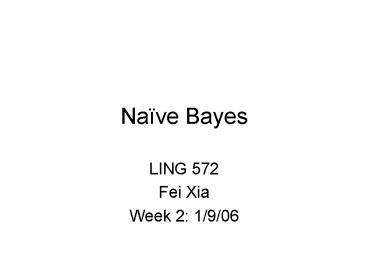Na - PowerPoint PPT Presentation
1 / 27
Title:
Na
Description:
MAP (maximum a posteriori) decision rule: classify (x) = classify (f1, .., fd) = argmaxc p(c|x) ... For each position, P(w=a)=p1, P(w=b)=p2 and P(w=c)=p3. ... – PowerPoint PPT presentation
Number of Views:478
Avg rating:3.0/5.0
Title: Na
1
Naïve Bayes
- LING 572
- Fei Xia
- Week 2 1/9/06
2
Outline
- Naïve Bayes in general
- Naïve Bayes for TC
3
Questions
- Why is it called Naïve Bayes?
- What objective function does it optimize?
- How many types of model parameters?
- What happen at the training time?
- What happen at the test time?
- Any variations?
4
Modeling
- Given x(f1, , fd), find
- c arg maxc P(cx)
- arg maxc P(c) P(xc) / P(x) ? Bayes
- arg maxc P(c) P(xc)
- Independence assumption
- P(xc) P(f1, f2, , fd c)
- ?k P(fk c, f1k-1)
- ¼ ?k P(fk c) ? Naïve
5
Naïve Bayes Model
C
fn
f2
f1
Assumption each fi is conditionally independent
from fj given C.
6
Model parameters
- Choose
- c arg maxc P(c) ?k P(fk c)
- Two types of model parameters
- Class prior P(c)
- Conditional prob P(fk c)
- The number of parameters
- CCV
- How many parameters are free?
7
Training estimating parameters ?
- Maximum likelihood (ML)
- ? arg max? P(trainingData ?)
- P(fk ci) Cnt(fk, ci) / Cnt(ci)
- P(ci) Cnt(ci) / ?i Cnt(ci)
8
Laplace Estimate/Correction/Smoothing
- Pretend you saw outcome one more than you
actually did. - Suppose X has K possible outcomes, and the counts
for them are n1, , nK , which sum to N. - Without smoothing P(Xi) ni /N
- With Laplace smoothing P(Xi) (ni 1) / (NK)
- It can be derived from Dirichlet priors as a MAP
estimate.
9
Classifying
- MAP (maximum a posteriori) decision rule
- classify (x)
- classify (f1, .., fd)
- argmaxc p(cx)
- argmaxc p(c) ?k p(fk c)
10
Naïve Bayes for TC
11
Features
- Features bag of words (word order information is
lost) - Number of feature templates 1
- Number of features V
- Features wt, t 2 1, 2, , V
12
Issues
- Is wt a binary feature?
- Are absent features used for calculating P(dj
ci) ?
13
Two Naive Bayes Models (McCallum and Nigram,
1998)
- Multi-variate Bernoulli event model
- (a.k.a. binary independence model)
- All features are binary the number of times a
feature occurs in an instance is ignored. - When calculating p(d c), all features are used,
including the absent features. - Multinomial event model unigram LM
14
Bernoulli distribution
- Bernoulli distribution has exactly two mutually
exclusive outcomes P(X1)p and P(X0)1-p. - Bernoulli trial a single experiment which can
have one of two possible outcomes - A Bernoulli process is a sequence of iid
(independent identically distributed) Bernoulli
trials.
15
Multi-variate Bernoulli Model
- A document is seen as a collection of V
independent Bernoulli experiments, one for each
word in the vocabulary does this word appear in
the document? - Let Bit 1 if wt appears in di
- 0 otherwise
- Modeling
- P(di cj) ?k ( Bit P(wt cj) (1-Bit)
(1 P(wt cj)) - Training
- P(ci) DocNum(ci) / DocNum
16
Training (cont)
- P(wt cj)
- (1DocNum(wt, cj)) / (2DocNum(cj))
Where P(cj di) 1 if di has the label cj
0 otherwise
17
Questions about Bernoulli event model?
18
Multinomial distribution
- Possible outcomes w1, w2, , wv
- A trial for each word position
- P(CurWordwi)pi and ?i pi 1
- Perform n Bernoulli trials n is the length of
the document - Let Xi be the number of times that the word wi is
observed in the document. - P(X1x1,,Xvxv n!/(x1!...xv!) p1x1pvxv
- n! ?k (pkxk
/ xk!)
19
An example
- Suppose
- the voc, V, contains only three words a, b, and
c. - a document, di, contains only 2 word tokens
- For each position, P(wa)p1, P(wb)p2 and
P(wc)p3. - What is the prob that we see a once and b
once in di?
20
An example (cont)
- 9 possible sequences aa, ab, ac, ba, bb, bc, cc,
cb, cc. - The number of sequences with one a and one b
(ab and ba) n!/(x1!...xv!) - The prob of the sequence ab is p1p2,
- so is the prob of the sequence ba.
- So the prob of seeing a once and b once is
n! ?k (pkxk / xk!) 2 p1p2
21
Multinomial Model
- A document is seen as an order sequence of word
events, drawn from the vocabulary V. - Nit the number of times that wt appears in di
- Modeling multinomial distribution
22
Training for multinomial model
23
Two models
- Bernoulli event model treat features as binary
each trial corresponds to a feature. - Multinomial event model treat features as
non-binary each trial corresponds to a word
position in the document. - Multinomial event model usually beats the
Bernoulli event model (McCallum and Nigram,
1998)
24
Summary of Naïve Bayes
- It makes a strong independence assumption.
- It generally works well despite the strong
assumption. Why? - Both training and testing are simple and fast.
25
Summary of Naïve Bayes (cont)
- Strengths
- Simplicity (conceptual)
- Efficiency at training
- Efficiency at testing time
- Handling multi-class
- Scalability
- Output topN
- Weakness
- Theoretical validity
- Predication accuracy ??
- Stability and robustness
26
Today
- Classification algorithm overview
- Naïve Bayes in general
- Naïve Bayes for text classification
27
Coming up
- kNN and Rocchio on Thurs read the paper
- An additional lab session right after Thursdays
class. - Hw1 is due at 11pm on Sat no extension































